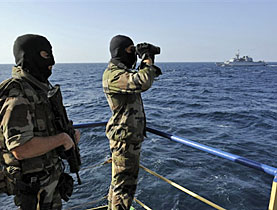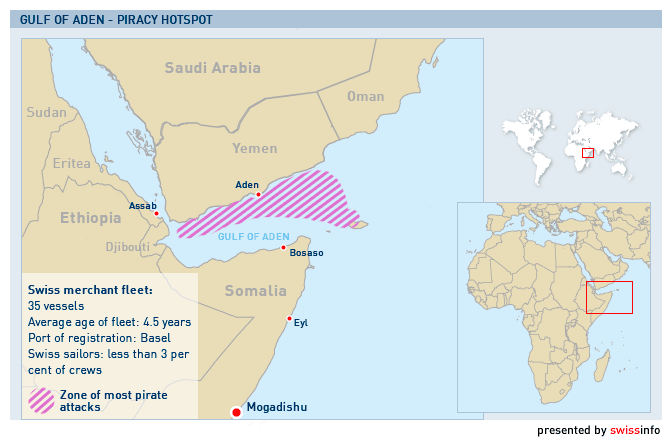
Helping the eyes see all the action

High-tech binoculars made in Switzerland are helping to make life more difficult for pirates who pose a serious threat to shipping off the coast of Somalia.
A recent photograph shows that French marines have been using the sophisticated Vector model from the Vectronix company, based at Heerbrugg in eastern Switzerland.
“The French have several thousand Vectors and they use them for a lot of applications. Unfortunately in the past few months and years, the threat coming from terrorists or pirates has been growing rapidly,” Vectronix CEO Jean Harter told swissinfo.
“They [the French] use it [in the Gulf of Aden] because they might see a ship or boat moving towards another, so they try to find out as much as possible and observe [whether there is a threat].”
The latest Vector model is an easy-to-use multifunctional optronic device with a 7x optic, a laser rangefinder which ranges up to a distance of 25 kilometres and an integrated digital magnetic compass with three-dimensional measurement capabilities.
“We also integrate night vision technologies, light intensification, or infrared,” Harter said.
Light and rugged
And they have to be light and very rugged. “They have to work at – 40 or -50 degrees Celsius and at + 50 or + 60. And they have to be resistant to salt water.” All Vector models are water resistant, and can float indefinitely on the surface of the water.
The company’s products are not only used by the military, but also by police, border guards, fire brigades, security companies and coastguards.
An increasing number of people are also using them for other outdoor activities “for example the skipper of [the] Swiss America’s Cup winning yacht team Alinghi had a Vector to find out where the others [yachts] were [during races]”.
Since the Vector is in service with 55 nations, and has been used by every Nato country, there is a question mark in some people’s minds whether this is a passive or active device, and whether it is classified as war material.
Regulations
“Vector is a passive device. The export is regulated by the Wassenaar Arrangement, with 40 participating countries, including Switzerland,” said Harter.
The accord concerns export controls for conventional arms and dual-use goods and technologies.
Vectronix, which can trace its history back to 1921, has a staff of about 200 and achieved sales last year of just over SFr100 million ($86.18 million).
Despite the current financial crisis, it is looking to the future with confidence.
Vision and strategy
“We have an opportunity because we anticipated [this] a year ago. We have prepared ourselves. We have a clear vision and strategy. We have changed the organisation to be fit, meaning in particular lean production and reduced time to market,” Harter said.
“We introduced nine new products in the market last year so we are in a good shape and we want to take advantage of this situation by managing the company by its cash flow.”
When French group Sagem took over Vectronix in 2003, the turnover that year was about SFr50 million, a figure that has now more than doubled.
“We delivered about 800 Vectors in about three weeks in December when we thought the maximum before was 400, and we achieved annual sales of SFr101.8 million, and this was a 15 per cent growth over the year before.”
“Our medium-term plan is that we want to reach SFr200 million in four years.”
Harter believes that the hand-held optronic market will grow, with a particular impulse coming from non-military use.
“This will increase the volume and decrease the price so we have to adapt ourselves to this market because there will be new entrants, new people, new companies. We have to be prepared.”
As part of those preparations is the construction of a new 5,000 square metre building next to the Heerbrugg headquarters, which will be finished in June.
swissinfo, Robert Brookes in Heerbrugg
When the Vector appeared in 1992, it was the world’s first binocular with distance and angle measuring capabilities.
Its maximum range was one kilometre, good enough for nature lovers and sports enthusiasts, but too short for military applications.
It was then developed using new optical concepts, better materials, improved processes and refined algorithms.
Today’s top model measures distances greater than 25 km.


In compliance with the JTI standards
More: SWI swissinfo.ch certified by the Journalism Trust Initiative


























You can find an overview of ongoing debates with our journalists here . Please join us!
If you want to start a conversation about a topic raised in this article or want to report factual errors, email us at english@swissinfo.ch.